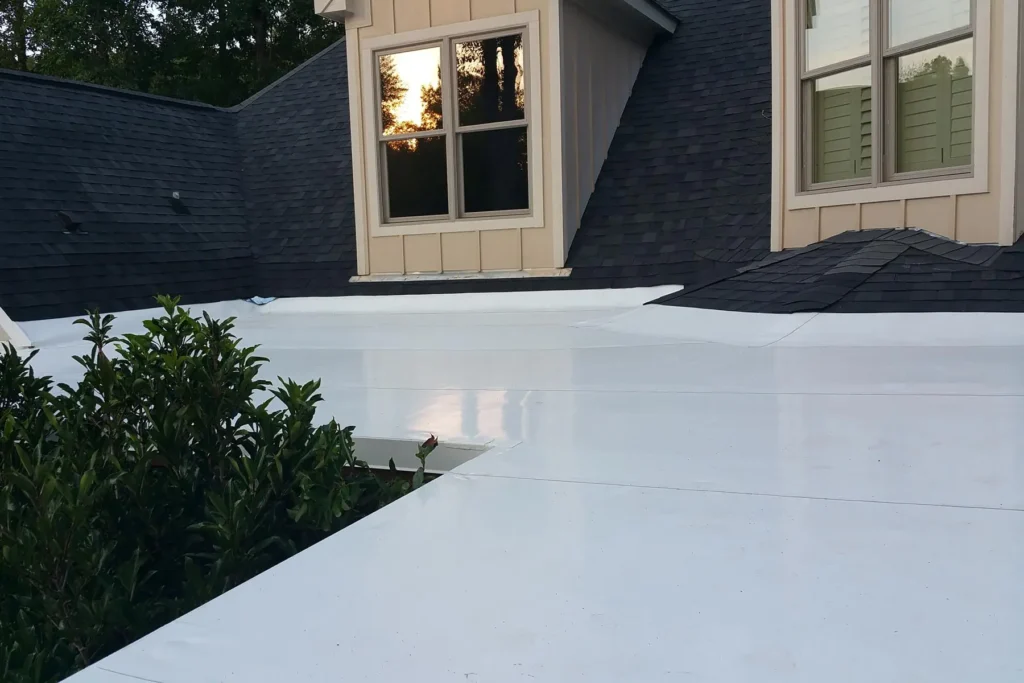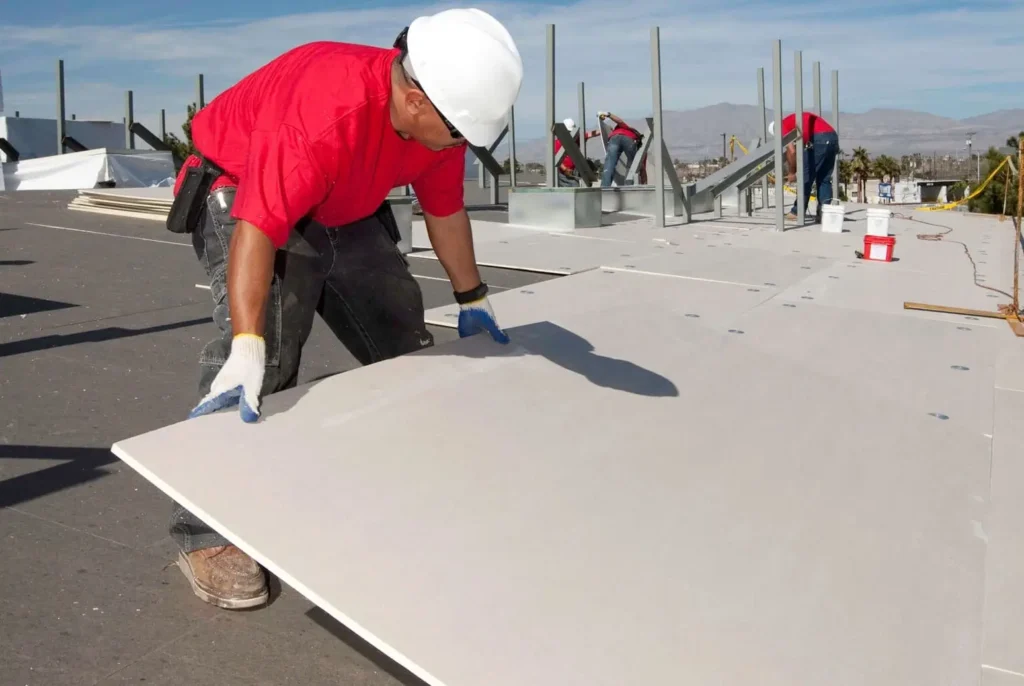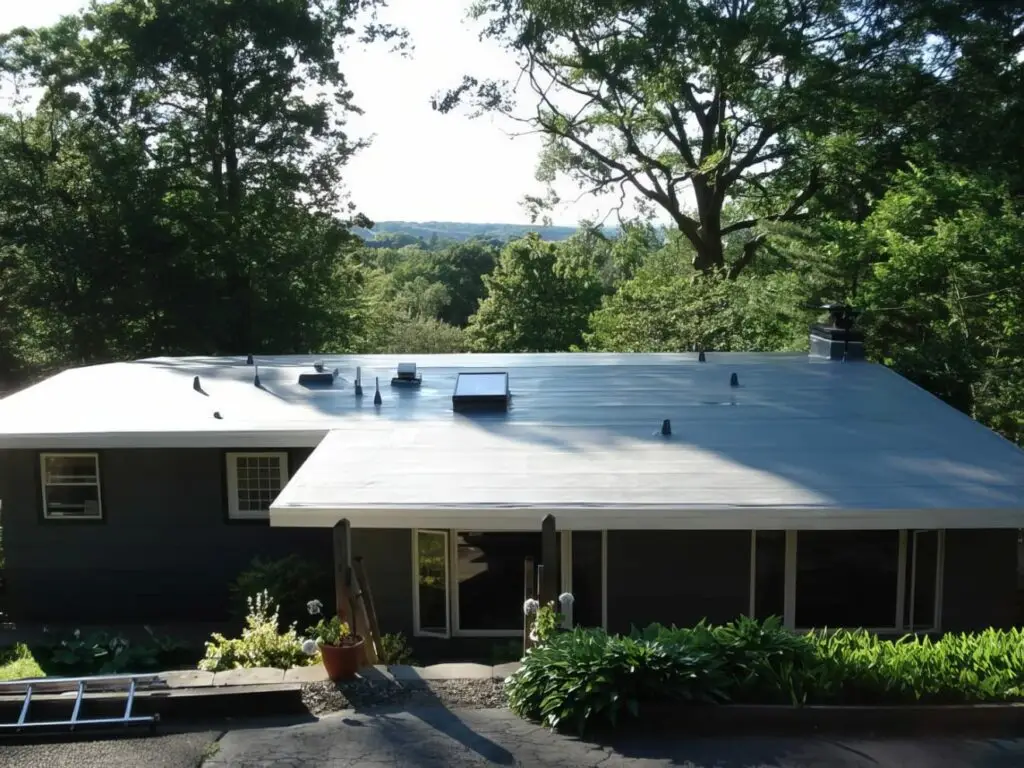Flat Roof Replacement: Complete Cost & Installation Guide for Long Island Homes
FINANCE YOUR HOME IMPROVEMENT PROJECT TODAY
0% Financing on
Roof Replacements
With nearly four decades serving homeowners under our belt, we’ve built relationships with trusted lenders who specialize in roofing projects. We can connect you with financing professionals ready to help fund your roof replacement project.
When you work with County Roofing, you get only the best. As little as 0% interest on approval for 5 years, easy pay, and the best craftsmanship in the industry.
Key Takeaways:
- Flat roof replacement costs $4-$15 per square foot on Long Island, with most homeowners paying $6,000-$15,000 for an average-sized roof
- Material choice significantly impacts both upfront costs and long-term performance—TPO, EPDM, and modified bitumen each offer distinct advantages
- Professional installation is critical for flat roofs due to drainage requirements, seam sealing, and waterproofing complexity
- Proper maintenance extends flat roof lifespan from 15-20 years to 25-30 years or more
- Signs you need replacement include recurring leaks, ponding water, visible membrane damage, and roofs older than 20 years

DEPENDABLE ROOF SERVICES FOR YOUR NASSAU HOME
How Much Does Flat Roof Replacement Cost?
Flat roof replacement on Long Island typically costs $4-$15 per square foot, with most residential projects falling in the $6-$12 range.
The price range is wide as it depends on a variety of factors, but we’ll break down some general price points to give you better idea of what to expect.
For context, here’s what that means for common roof sizes:
- 800 sq ft flat roof: $4,800-$12,000
- 1,200 sq ft flat roof: $7,200-$18,000
- 1,600 sq ft flat roof: $9,600-$24,000
- 2,000 sq ft flat roof: $12,000-$30,000
Why such a wide range? Several factors drive the final cost, and understanding them helps you budget accurately.
Let’s talk about those now.
Material Type Makes the Biggest Difference
Your choice of roofing material creates the largest cost variation. TPO and EPDM systems run $4-$8 per square foot installed, while premium PVC or metal roofing can reach $12-$15 per square foot or higher.
We’ll dive deeper into material options shortly, but remember: cheaper upfront doesn’t always mean better value. A $5,000 roof that lasts 15 years costs more per year than a $9,000 roof that lasts 30 years.
Roof Size and Complexity
Larger roofs benefit from economy of scale. Smaller flat roofs actually cost more per square foot because setup, equipment, and minimum service fees get spread across less square footage.
Complexity matters too. Multiple roof penetrations—HVAC units, vents, skylights, chimneys—add labor time and materials for proper flashing and sealing. Each penetration represents a potential leak point that demands careful installation.
Condition of Existing Roof
If your roof decking has water damage or rot, those repairs add to replacement costs. Structural issues discovered during tear-off can add $1,000-$5,000 to your project, depending on extent.
This is why thorough pre-installation inspections matter. Reputable contractors identify potential issues upfront rather than surprising you mid-project with change orders.
Removal and Disposal
Tearing off your old flat roof costs $1-$5 per square foot. That’s $800-$4,000 for a 1,000 sq ft roof just for removal and disposal.
Some contractors include this in their base quote. Others bill separately. Always clarify whether tear-off is included when comparing estimates.
Local Labor Rates
Long Island labor rates run higher than national averages. Factor in our higher cost of living, building code requirements, and demand for quality work.
Expect to pay $40-$80 per hour for skilled roofing labor on Long Island. Complex installations requiring specialized skills command premium rates.

Understanding Flat Roof Materials
Choosing the right material for your Long Island flat roof means balancing upfront cost, lifespan, maintenance requirements, and performance in our variable climate.
TPO (Thermoplastic Polyolefin)
TPO is one of the most popular commercial and residential flat roofing options. This white, reflective membrane offers excellent energy efficiency by reflecting summer heat and reducing cooling costs.
Cost: $4-$10 per square foot installed
Lifespan: 20-30 years with proper maintenance
Pros: Energy-efficient, heat-welded seams create watertight bonds, resists UV damage, available in various widths that minimize seams
Cons: Requires skilled installation—improper seam welding causes premature failure, can become brittle in extreme cold
TPO works particularly well on Long Island because the reflective surface combats our hot, humid summers while the material handles our freeze-thaw cycles reasonably well.
EPDM (Rubber Roofing)
EPDM, commonly called rubber roofing, has protected flat roofs for over 50 years. This proven material delivers reliable performance at competitive pricing.
Cost: $4-$8 per square foot installed
Lifespan: 25-30 years
Pros: Proven durability, handles temperature extremes well, relatively easy repairs, cost-effective, resists ozone and UV damage
Cons: Black surface absorbs heat (white EPDM available at higher cost), seams use adhesive or tape that can fail if improperly installed, can puncture from sharp objects
For Long Island homeowners watching budgets without sacrificing quality, EPDM represents solid value. It performs reliably in our climate when properly installed and maintained.
PVC (Polyvinyl Chloride)
PVC roofing delivers premium performance with a premium price tag. Chemical resistance and superior durability make PVC ideal for roofs exposed to grease, oils, or harsh chemicals.
Cost: $7-$12 per square foot installed
Lifespan: 20-30 years
Pros: Superior chemical resistance, highly durable, heat-welded seams, naturally fire-resistant, highly reflective
Cons: Higher upfront cost, can become brittle in extreme cold, requires experienced installers
Commercial kitchens and properties near coastal salt exposure benefit from PVC’s enhanced resistance to chemicals and environmental stress.
Modified Bitumen
Modified bitumen offers multi-layer protection similar to traditional built-up roofing but with modern enhancements. Think of it as an upgraded version of traditional tar and gravel roofs.
Cost: $4-$8 per square foot installed
Lifespan: 15-20 years
Pros: Multiple layers provide redundancy, granulated surface resists UV damage, handles foot traffic better than membrane systems, relatively easy repairs
Cons: Shorter lifespan than TPO or EPDM, installation requires torch application (fire risk), heavier than single-ply membranes
Modified bitumen makes sense for roofs that experience regular foot traffic or when you want the security of multiple protective layers.
Metal Roofing
Metal flat roofs represent the premium end of the market. With proper installation, metal roofs can last 40-60 years—potentially the last roof you’ll ever need.
Cost: $8-$16 per square foot installed
Lifespan: 40-60+ years
Pros: Exceptional durability, minimal maintenance, energy-efficient with reflective coatings, environmentally friendly, handles snow and ice well
Cons: Highest upfront cost, noise during rain, requires slope for drainage, potential for denting from hail or falling branches
Standing seam metal roofing works beautifully on flat roofs with proper pitch. The initial investment pays off through decades of worry-free performance.
For a deeper dive into commercial flat roofing options, check out our complete commercial roofing guide.
THE BEST WARRANTIES IN THE INDUSTRY- ONLY 2% OF ROOFING COMPANIES CAN OFFER
25-Year Labor, 50-Year Material Warranty
We’ve met the toughest requirements in the residential roofing industry- and we use only the best materials.
That’s why we stand behind our work with the best warranties in the industry- warranties only 2% of the roofing industry can offer.
Your house deserves the best roofing warranty on the market. Give us a call today and get a brand new roof with a 25-year labor, 50-year material warranty from the best roofing contractor throughout Long Island and New York.
The Flat Roof Replacement Process
Understanding what happens during flat roof replacement helps you prepare and know what to expect.
Initial Inspection and Assessment
A thorough roof inspection identifies all issues before work begins. Professional contractors examine the entire roofing system—membrane condition, flashing, drainage, decking, insulation, and penetrations.
This assessment determines whether you need full replacement or if targeted flat roof repairs will suffice. Sometimes what looks like major damage requires only localized repairs.
Tear-Off and Disposal
Complete removal exposes the roof deck, allowing contractors to assess structural integrity. All old roofing material, damaged insulation, and failed components get removed and properly disposed of.
Some situations allow for overlays where new roofing goes over existing material. However, this approach limits your ability to inspect and repair the deck. Most professionals recommend complete tear-off for optimal results.
Deck Inspection and Repairs
With the old roof removed, contractors inspect the roof deck for water damage, rot, or structural issues. Any damaged decking gets replaced before new roofing installation begins.
This step is critical. Installing new roofing over compromised decking sets you up for premature failure and wasted money.
Insulation Installation
Modern flat roofs include insulation that improves energy efficiency and provides a stable base for the roofing membrane. Proper insulation placement varies by roof type—cold roofs, warm roofs, and inverted roofs each require specific configurations.
Insulation adds $1-$4 per square foot to your project but pays for itself through reduced heating and cooling costs.
Membrane Installation
Membrane installation technique depends on your chosen material. TPO and PVC use heat-welded seams. EPDM uses adhesive or mechanical fastening. Modified bitumen requires torch application.
This is where professional expertise matters most. Improperly sealed seams, inadequate adhesive coverage, or poor welding technique cause the majority of premature flat roof failures.
Flashing and Penetration Sealing
Every roof penetration—vents, pipes, HVAC equipment, skylights—requires custom flashing to prevent water infiltration. Flashing represents the most vulnerable area on any flat roof.
Quality contractors take extra time at penetrations, ensuring proper overlap, secure attachment, and complete sealing. Rushed flashing work guarantees future leaks.
Drainage Installation
Unlike pitched roofs where gravity does the work, flat roofs need properly positioned drains, scuppers, or edge systems to move water off the surface. Even “flat” roofs require minimal slope (typically 1/4 inch per foot) to prevent water pooling.
Poor drainage is the leading cause of flat roof problems. Standing water degrades roofing materials and finds its way through seams and penetrations.
Final Inspection and Cleanup
Thorough cleanup removes all debris, fasteners, and materials. A comprehensive final inspection ensures every seam is properly sealed, all flashing is secure, and drainage functions correctly.
Reputable contractors walk you through the completed work, explaining maintenance requirements and warranty coverage.

Flat Roof vs. Pitched Roof: Understanding the Differences
Considering whether a flat roof is right for your home? Here’s how they compare to traditional pitched roofs.
Cost Comparison
Flat roofs typically cost less initially because they require less material and simpler framing.
A flat roof might run $6-$12 per square foot while a pitched roof costs $8-$18 per square foot installed.
However, factor in lifespan differences. Pitched roofs often last 25-50 years. Flat roofs typically last 15-30 years, though modern materials are closing that gap.
Maintenance Requirements
Flat roofs demand more frequent maintenance.
Plan on professional inspections twice yearly plus regular drain cleaning to prevent debris accumulation and ensure proper water flow.
Pitched roofs shed water and debris more effectively, requiring less frequent maintenance.
Drainage Challenges
This is flat roofing’s biggest challenge.
Water pooling accelerates membrane degradation and increases leak risk. Proper initial slope and diligent drain maintenance are non-negotiable.
Pitched roofs naturally shed water, reducing this concern substantially.
Usable Space
Flat roofs offer a major advantage here.
You gain usable outdoor space for roof decks, gardens, HVAC equipment, or solar panels. This matters significantly on smaller urban lots where every square foot counts.
Some Long Island homeowners create stunning rooftop entertainment spaces or growing gardens on their flat roofs.
For more information on residential applications, see our residential flat roof guide.
Energy Efficiency
Modern reflective flat roofing membranes excel at reflecting summer heat.
White TPO or PVC roofs can reduce cooling costs by 10-20% compared to traditional dark shingles.
However, flat roofs offer less attic space for insulation. Proper insulation installation becomes more critical.
Aesthetic Considerations
Flat roofs provide clean, modern aesthetics that suit contemporary architecture beautifully.
Traditional homes typically look better with pitched roofs that match the architectural style.
Consider your home’s design, neighborhood character, and personal preferences when deciding between flat and pitched.
Signs You Need Flat Roof Replacement
Knowing when to replace rather than repair saves money and prevents interior damage.
Recurring Leaks
One leak might mean localized damage.
Multiple leaks or leaks that return after repairs indicate systemic failure requiring replacement.
If you’re calling for leak repairs every year or two, replacement becomes more cost-effective than ongoing patch work.
Ponding Water
Water standing on your flat roof for more than 48 hours after rain signals drainage problems.
Chronic ponding accelerates membrane breakdown and guarantees premature failure.
Sometimes improved drainage solves this. Often it indicates insufficient slope requiring roof reconstruction.
Visible Membrane Damage
Large areas of cracking, bubbling, splitting, or alligatoring (surface cracking resembling alligator skin) mean your membrane is failing.
Small damaged areas can be repaired. Widespread damage requires replacement.
Age of Roof
Most flat roofs reach the end of their reliable lifespan at 20-25 years.
If your roof approaches 20 years and shows any issues, replacement makes more sense than repair.
Even without visible problems, aging roofs become increasingly prone to sudden failure.
Interior Water Damage
Water stains on ceilings, damp insulation, or visible mold indicate your roof is already failing.
Don’t wait for small leaks to become big problems.
Interior damage repair often costs more than the roofing work itself.
Seam Separation
Flat roof seams are the weakest point in any membrane system. Visible seam separation or lifting indicates adhesive failure that will only worsen with time.
Resealing might work temporarily, but extensive seam failure points toward replacement.
Why Professional Installation Matters
Flat roof replacement isn’t a DIY project. Here’s why professional installation is non-negotiable.
Drainage Design Expertise
Creating proper slope and positioning drains requires engineering knowledge that most homeowners lack. Improper drainage dooms even the best materials to premature failure.
Professional contractors understand how water moves and design drainage systems that work reliably for decades.
Seam Sealing Techniques
TPO and PVC seam welding requires specialized hot-air welding equipment and extensive training. Improperly welded seams fail within months, causing leaks and requiring expensive repairs.
EPDM seaming demands meticulous surface preparation and precise adhesive application. Amateur application virtually guarantees seam failure.
Flashing Complexity
Properly flashing roof penetrations, edges, and transitions requires understanding how different materials expand and contract. Poor flashing causes 90% of flat roof leaks.
Professionals know exactly how to seal each penetration type for watertight performance in all weather conditions.
Material Handling
Roofing membranes arrive in large, heavy rolls requiring proper handling, storage, and installation.
Improper handling creases membranes, compromising performance before installation even begins.
Safety Considerations
Flat roof work involves working at height, handling heavy materials, operating specialized equipment, and potential exposure to heat from torch-applied systems.
Professional crews have safety equipment, training, and insurance that protect both workers and homeowners.
Warranty Protection
Most manufacturers void material warranties if installation isn’t performed by certified contractors. Professional installation protects both workmanship and material warranties.
Building Code Compliance
Long Island building codes specify requirements for roof insulation values, fire resistance, wind uplift resistance, and drainage. Professional contractors ensure your new roof meets all code requirements, preventing issues during home sales or insurance claims.
Extending Your Flat Roof’s Lifespan
Proper maintenance significantly extends flat roof performance.
Bi-Annual Inspections
Have your flat roof professionally inspected in spring and fall. Inspections catch small issues before they become expensive problems.
Look for membrane damage, seam separation, flashing issues, and drainage problems.
Regular Drain Cleaning
Keep drains, scuppers, and gutters clear of debris. Clogged drains cause water pooling that accelerates membrane degradation.
Clean drains after major storms and before winter when leaves accumulate.
Prompt Leak Repairs
Address leaks immediately. Water infiltration damages insulation, decking, and interior finishes. What starts as a simple membrane patch becomes a major reconstruction project if ignored.
Avoid Roof Traffic
Limit foot traffic on your flat roof. Walking on roofing membranes causes wear and potential punctures. When roof access is necessary, use walk pads to distribute weight.
Coating Applications
Applying reflective roof coatings every 5-7 years refreshes UV protection and extends membrane life. Coatings cost $1-$3 per square foot—far less than replacement.
Professional Maintenance
Consider annual maintenance contracts with professional roofing companies. Preventive maintenance identifies and addresses minor issues before they require costly repairs.

Do It Right (the First Time) With County Roofing Systems
Flat roof replacement represents a significant investment, typically $6,000-$15,000 for most Long Island residential properties. However, that investment protects your home, prevents costly interior damage, and can provide 20-30 years of reliable performance when done right.
The key is working with experienced professionals who understand flat roofing’s unique demands—proper drainage design, meticulous seam sealing, expert flashing installation, and material-specific installation techniques.
Cutting corners or choosing the lowest bid often means paying twice. Amateur installation virtually guarantees premature failure, requiring replacement far sooner than properly installed roofs.
We’ve been serving Long Island for over 35 years, specializing in residential flat roofing systems that deliver decades of worry-free performance. Our team of fully certified and trained professionals understands exactly what Long Island flat roofs need to withstand our demanding climate—from hot, humid summers to harsh winter freeze-thaw cycles.
Don’t trust your flat roof replacement to inexperienced contractors. County Roofing Systems brings the expertise, quality materials, and meticulous attention to detail that ensures your new flat roof performs reliably for decades. Contact us today for a free, detailed estimate and experience the difference that professional flat roof installation makes.
0% financing
No income check
Up to 15 years
Monthly payments as low as $149
Call or Contact Us Today for a FREE roofing estimate:
Frequently Asked Questions
How long does a flat roof replacement take?
Can I install a new flat roof over my existing roof?
Do flat roofs always leak?
What's the best flat roofing material for Long Island?
How often should I inspect my flat roof?

